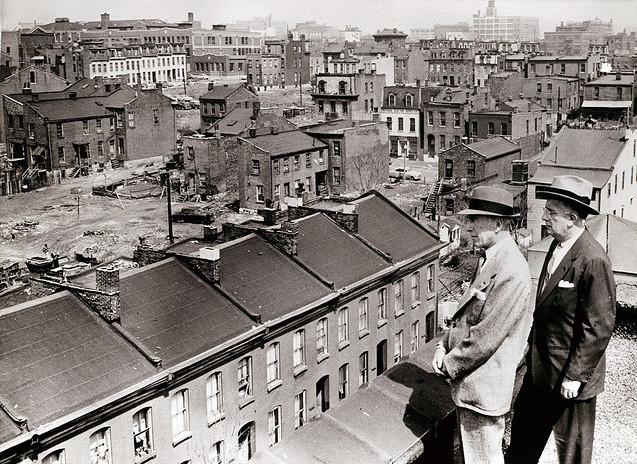Physical Address
304 North Cardinal St.
Dorchester Center, MA 02124
Physical Address
304 North Cardinal St.
Dorchester Center, MA 02124

Houston doesn’t have zoning. As I have written about previously here on the blog, this doesn’t mean nearly as much as you would think. Sure, Houston’s municipal government doesn’t segregate uses or expressly regulate densities. But as my Market Urbanism colleague Michael Lewyn has documented, city officials do regulate lot sizes, setbacks, and parking requirements. They also enforce private deed restrictions, which blanket many of the city’s residential neighborhoods. A deed restriction is a legal agreement among neighbors about how they can and cannot use their property. In most cities, deed restrictions are purely private and often fairly marginal, adding rules on top of zoning that property owners must follow. But in Houston, deed restrictions do most of the heavy lifting typically covered by zoning, including delineating permissible uses and design standards. Whenever I point out that Houston has relatively light land-use regulations (and is enjoying the benefits), folks often respond that the city’s deed restrictions are basically zoning. This couldn’t be further from the truth. Before I turn to the essential differences, it’s worth first observing how Houston’s deed restrictions are like any other city’s zoning. First, like zoning, Houston’s deed restrictions are almost universally designed to prop up the values of single-family houses. Despite the weak evidence for a use segregation-property values connection, this justification for zoning goes back to the program’s roots in the 1920s. Many of Houston’s nicest residential neighborhoods, like River Oaks and Tanglewood, follow this line of thinking, enforcing tight deed restrictions on residents that come out looking a lot like zoned neighborhoods in nearby municipalities like Bellaire and Jersey Village. Second, both zoning and Houston’s deed restrictions are enforced by government officials at taxpayer expense. In most other cities, deed restrictions are overseen and enforced by a private group like a homeowners association, […]

Spoiler Warning: This post contains minor spoilers about Season Two of Parks and Recreation, which aired nearly 10 years ago. Why have you still not watched it? Lately I have been rewatching Parks and Recreation, motivated in part by the shocking discovery that my girlfriend never made it past the first season. The show is perhaps the most sympathetic cultural representation of local public sector work ever produced in the United States. The show manages to balance an awareness of popular discontent with “government” in the abstract— explored through a myriad of ridiculous situations—with the more mild reality that most local government employees are well-meaning, normal, mostly harmless people who care about their communities. This makes the character of Mark Brendanawicz, Pawnee’s jaded planner, all the more interesting. It’s conspicuous that even in a show so sympathetic to local government, the city planner remains a cynical, somewhat unlikable character. Unlike Ron Swanson, Brendanawicz at one point meant well and has no ideological issues with government; he regularly suggests that he was once a true believer in his work, if only for “two months.” Yet unlike Leslie Knope, he didn’t choose government. In his efforts to win back Anne, Andy chides Brendanawicz as a “failed architect,” an insult which seems to stick. Brendanawicz ultimately leaves the show as an unredeemed loser: after taming his apparent self-absorption and promiscuity, he prepares to propose to Anne, only to have her preemptively break up with him. When the government shutdown occurs at the end of Season Two, Brendanawicz takes a buyout offer, and resolves to go into private-sector construction. Leslie, who had once adored him, dubs him “Brendanaquits,” and we never hear from Pawnee’s city planner again. It isn’t hard to see why Brendanawicz was unceremoniously scrapped: he was ultimately a call-back to the harsher world […]

The great failing of modern land-use regulation is the failure to allow densities to naturally change over time. Let me explain. Imagine you are trying to sell a property you own in a desirable inner suburban neighborhood in your town. The lot is 4,000 square feet and hosts an old 4,000 square-foot home. There is incredible demand for housing in this area; perhaps the schools are good, or the amenities are nice, or the neighborhood sits adjacent to a major jobs center, meaning that residents can walk to work. I’ll leave the reasons to you. Who do you sell it to? You have at least two options: First, you could sell it to a wealthy individual, who would use the entire property as his home. He is willing to pay the market rate for single-family homes like this, which in this case is $300,000. Under current financing, he would likely have a monthly mortgage payment in the ballpark of $1,300. Second, you could sell it to a developer who intends to subdivide the house into four 1,000 square foot one-bedroom apartments, renting each of them at a market rate of $500 to service workers who commute to downtown. After factoring in expenses, her annual net operating income would be around $20,160. Assuming a multifamily cap rate of 6.0.%, this means that she could pay up to $336,000 for your property. Based on this analysis, who do you sell it to? The answer is obvious: you will sell it to the multifamily developer who will subdivide and rent out the house, not necessarily because you’re a bleeding heart urbanist, but in order to maximize your earnings. As rents in the area rise, the pressure to sell to a buyer who would densify the property will only grow. The prospective mansion buyer […]

In my regular discussions of U.S. zoning, I often hear a defense that goes something like this: “You may have concerns about zoning, but it sure is popular with the American people. After all, every state has approved of zoning and virtually every city in the country has implemented zoning.” One of two implications might be drawn from this defense of Euclidean zoning: First, perhaps conventional zoning critics are missing some redeeming benefit that obviates its many costs. Second, like it or not, we live in a democratic country and zoning as it exists today is evidently the will of the people and thus deserves your respect. The first possible interpretation is vague and unsatisfying. The second possible interpretation, however, is what I take to really be at the heart of this defense. After all, Americans love to make “love it or leave it” arguments when they’re in the temporary majority on a policy. But is Euclidean zoning actually popular? The evidence for any kind of mass support for zoning in the early days is surprisingly weak. Despite the revolutionary impact that zoning would have on how cities operate, many cities quietly adopted zoning through administrative means. Occasionally city councils would design and adopt zoning regimes on their own, but often they would simply authorize the local executive to establish and staff a zoning commission. Houston was among the only major U.S. city to put zoning to a public vote—a surefire way to gauge popularity, if it were there—and it was rejected in all five referendums. In the most recent referendum in 1995, low-income and minority residents voted overwhelmingly against zoning. Houston lacks zoning to this day. Meanwhile, the major proponents of early zoning programs in cities like New York and Chicago were business groups and elite philanthropists. Where votes were […]

At 4:30 am, alarms on my cellphone and tablet start beeping, just enough out of sync to prompt me to get up and turn them off. By 5:00 am, I riding as a passenger along an unusually sedate New Jersey Turnpike, making friendly conversation with my driver and survey partner to make sure he stays awake. At 5:30am, as most of the city sleeps, we find a drab concrete picnic table outside the bus depot and chow down on our cold, prepared breakfasts. Around us, buses are revving up and their drivers are chatting and smoking cigarettes. At 5:50 am, we find our bus and introduce ourselves to our driver for the day. All of the Alliance drivers seem to be Hispanic. Our run begins. You wouldn’t expect it, but the first run is always the sweetest. The riders trickle on, making it easy to approach them, and unlike the typical 8:00 am rush hour rider they are usually friendly and receptive to my request. I approach them and mechanically incant “Good morning Sir/Ma’am. Would you like to take a survey on your commute today for NJ Transit? It will only take a few minutes of your time.” My partner sits in the front, tallying the boardings, exits, and survey refusals. We will spend the next eight hours zigzagging across the New York City metropolitan area, asking harried riders about their commute. For the past month or so, this has been my part-time job: surveying bus riders about their origins, destinations, and travel preferences for NJ Transit. The job is just engaging enough that I rarely have time for sleeping or class readings, but has enough slow periods that my mind can wander on the question of bus planning. Although I am not authorized to read any of the surveys […]

You wake up thirty minutes before your alarm, jerking up after having a nightmare about a car crash. Reluctantly, you clean up, eat breakfast, and hop into your car. Work is only three mile away—easy biking distance—and there are 15 or so people in your neighborhood who work where you work—enough for a commuter bus make sense. But alas, the city required the developer to provide two parking spaces for your townhouse and the cost is hidden somewhere in your mortgage, so why not use it? After spending thirty minutes traveling three miles on the freeway—at least we live in the Golden Age of Podcasting, right?—you arrive at your suburban office park and pull into the garage. The parking is “free,” meaning that your pay has already been docked to cover the cost of the space, so why not use it? Your girlfriend calls shortly after lunch, asking if you want to go on a double dinner date with her friends to a new BBQ place downtown. You agree to join. You’re starving—you left lunch at home and it’s just too time consuming to drive to a decent place—so you hustle downtown. You arrive first, only to find out that there is only on-street parking. Downtown is, after all, exempt from parking requirements, and since street parking is “free,” it’s impossible to find a space during dinner time. You call your dinner partners—each of them is driving separately from work—and suggest another BBQ place downtown that offers subsidized garage parking. This place is a little more expensive, since the restaurateur has to cover some of the cost of offering parking, but you’re all hungry and don’t want to deal with the headache of cruising for street parking. Eventually you all meet and enjoy a nice meal, speculating about how traffic […]

It is because every individual knows little and, in particular, because we rarely know which of us knows best that we trust the independent and competitive efforts of many to induce the emergence of what we shall want when we see it. — Friedrich Hayek, The Constitution of Liberty Imagine the perfect city. If you have a clear picture in mind, you’re not alone. Tsars, emperors, and prophets have been trying to build perfect cities for millennia. With the emergence of the field of urban planning and modern social science, everyone from stenographers to industrialists to independent architects have joined in. For Ebenezer Howard, the perfect city was the Garden City, a corporate-owned residential satellite on the outer edge of town. For Le Corbusier, it was the Ville Radieuse, full of “skyscrapers in the park” and elevated highways. For Frank Lloyd Wright, it was Broadacre City, a dispersed anti-city full of single-family homes on one-acre lots. Each reflects a distinct vision of urban life, and each seems to have as many opponents as it does proponents. Thankfully, few of these plans have ever been implemented in full on a mass scale. Yet “perfect city” thinking—the view that one particular vision of urban form should be imposed by planners—has manifested itself in small ways in cities around the world through the construction and enforcement of specific theories of how a city should work. This approach to urban form involves expanding urban planning beyond prudentially managing infrastructure and mitigating destructive negative externalities and toward enforcing and preserving particular lifestyle and aesthetic preferences. Consider: while Ville Radieuse was never built, many cities bulldozed traditional urban neighborhoods to construct the urban elevated highways of Le Corbusier’s dreams. While Broadacre City never moved beyond the model stage, many suburban communities still zone minimum lot sizes […]

Lexington, Kentucky is a wonderful place, and that’s getting to be a problem. There’s nothing intrinsically wrong with the city: its urban amenities, thriving information economy, and unique local culture have brought in throngs of economic migrants from locales as exotic as Appalachia, Mexico, and the Rust Belt. The problem, rather, is that the city isn’t zoned to support this newfound attention. Over the past five years, the city has grown by an estimated 18,000 residents, putting Lexington’s population at approximately 314,488. Lexington has nearly tripled in size since 1970 and the trend shows no signs of stopping, with an estimated 100,000 new residents arriving by 2030. Despite this growth, new development has largely lagged behind: despite the boom in new residents, the city has only permitted the construction of 6,021 new housing units over the past five years—not an awful ratio when compared to a San Francisco, but still putting us firmly on the path toward shortages. The lion’s share of this new development has taken the form of new single-family houses on the periphery of town. Create your own infographics. Sources: ACS/Census Bureau At the risk of sounding like a broken record, there’s nothing intrinsically wrong with single-family housing on the periphery of town. Yet in the case of Lexington, it’s suspect as a sustainable source of affordable housing. Lexington was the first American city to adopt an urban growth boundary (UGB), a now popular land-use regulation that limits outward urban expansion. As originally conceived, the UGB program isn’t such a bad idea: the city would simultaneously preserve nearby farmland and natural areas (especially important for Lexington, given our idyllic surrounding countryside) while easing restrictions on infill development. Create your own infographics. Source: Census Bureau The trouble with Lexington is that the city has undertaken […]

Planners, like all professions, have their own useful mythologies. A popular one goes something like this: “Many years ago, us planners did naughty things. We pushed around the poor, demolished minority neighborhoods, and forced gentrification. But that’s all over today. Now we protect the disadvantaged against the vagaries of the unrestrained market.” The seasoned—which is to say, cynical—planner may knowingly roll her eyes at this story, but for the true believer, this story holds spiritual significance. By doing right today, the reasoning goes, planners are undoing the horrors of yesterday. This raises the question: are planners doing right today? That’s not at all clear. Just ask Hinga Mbogo. After emigrating from Kenya, Mr. Mbogo opened Hinga’s Automotive in East Dallas in 1986. Mr. Mbogo’s modest business is precisely the kind of thing cities need, providing a service for the community, taxes for the city, and blue-collar jobs. While perhaps not of the “creative class,” Mr. Mbogo and his small business represent the type of creative little plan that cities cultivate and depend on. Hinga’s Automotive has thrived for 19 years and looked primed for another 19. Unfortunately for Mr. Mbogo, Dallas planners had other plans. In 2005, the city rezoned the area to prohibit auto-related businesses. While rezonings—particularly upzonings—aren’t necessarily a bad thing, Dallas planners opted to force their vision through and implemented a controversial planning technique known as “amortization.” Normally when planners rezone an area, they allow existing uses that run afoul of the new code to continue operating indefinitely. These are known as “non-conforming uses” and they’re common in neighborhoods across the country, often taking the form of neighborhood groceries, restaurants, and small industrial shops. Yet under amortization, the government forces non-conforming uses to cease operating without any compensation. In the case of Hinga’s Automotive, this means […]

This week on the Market Urbanism Podcast, I chat with Samuel Zipp and Nathan Storring on the wonderful new volume Vital Little Plans: The Short Works of Jane Jacobs. From Jacobs’ McCarthy-era defense of unorthodox thinking to snippets of her unpublished history of humanity, the book is a must-read for fans of Jane Jacobs. In this podcast, we discuss some of the broader themes of Jacobs’ thinking. Read more about the ideas discussed in this week’s episode: Pick up your copy of Vital Little Plans on Amazon. Mentioned in the podcast, Manuel DeLanda discusses Jane Jacobs in A Thousand Years of Nonlinear History. Read more about the West Village Houses here. The question of Quebec separatism is a fascinating—and under-considered—element of Jacobs’ work. Help spread the word! If you are enjoying the podcast, please subscribe and rate us on your favorite podcasting platform. Find us on iTunes, PlayerFM, Pocket Casts, Stitcher, and Soundcloud. Our theme music is “Origami” by Graham Bole, hosted on the Free Music Archive.